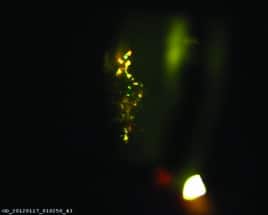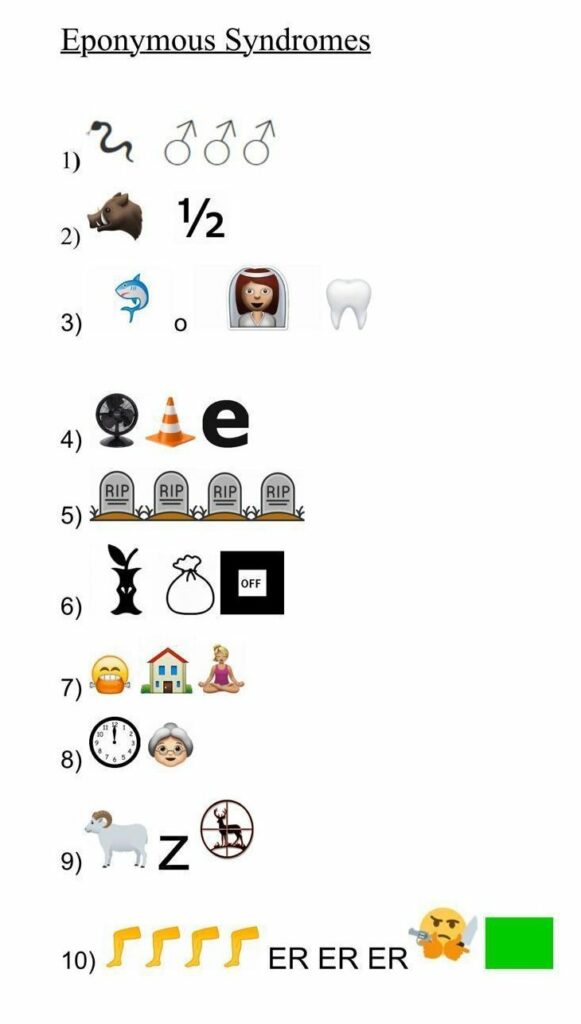Merry Funtabulously Frivolous Friday Five 330
Just when you thought your brain could unwind on a Friday, you realise that it would rather be challenged with some good old fashioned medical trivia FFFF, introducing the Funtabulously Frivolous Friday Five 330 – Christmas Edition
[Past XMAS editions…072 – 131 – 170 – 219 – 264 – 302]
Question 1
Christmas 1877, BMJ retold of a young man aged 22 who had been painting Christmas cards. It was noted that he used copious amount of Scheele’s Green. He presented with the following:
Vomiting and purging, accompanied with pain in the abdomen of a colicky character, and so severe as to be best expressed by the word excruciating. Along with these conditions were great weakness and quickness of the pulse (120), faintness, paleness of the face….
Joseph Farrar 1977
What has he poisoned himself with?
Reveal the funtabulous answer
Arsenic
The young man was so focussed on painting Christmas cards that he neglected to wash the copper hydrogen arsenite from under his nails before eating and often put the paintbrush in his mouth. At the time most green colours contained arsenic.
He was treated with sinapism (a mustard plaster), linseed poultices (as hot as could be borne). Tincture of opium for the diarrhoea, and half an ounce of brandy (it was Christmas after all). His condition improved the next day.
Karl Adolph von Basedow (1799 – 1854) first presented proof (1844, 1846) of the poisonous effect of wallpapers printed with the paint colour ‘Schweinfurther Grün‘ (Parisian green) and Scheelesgrün in ‘Arsenikdunst in Wohnzimmern‘ [Arsenic fumes in living rooms 1846;52(1):89].
In 1848, Basedow found that glue-bound Schweinfurter green releases organic arsenic compounds leading to arsenic vapours filling the confined spaces of living rooms. This was later (1935) deemed to be the production of trimethyl-arsine from fungus (Penicillium brevicaule)
References
- Basedow KA. Beobachtungen über die gesundheitsnachteiligen Ausdunstungen der zimmerfaden aus arsenikaurem Kupferoxyd. Wochenschrift für die gesammte Heilkunde. 1848;27:417-429 [Schweinfurther Grün]
- Farrar J. Case of Acute Arsenical Poisoning from the Use of Green Paint. Br Med J. 1877 Jan 6;1(836):8.
- Challenger F, Higginbottom C. The production of trimethylarsine by Penicillium brevicaule (Scopulariopsis brevicaulis). Biochem J. 1935; 29(7): 1757–1778
Question 2
What incidental finding is found on the slit lamp below:

Reveal the funtabulous answer
Christmas Tree Cataract or CTC for short.
This anterior segment photograph (Natung et al) of left eye (by slit lamp) shows highly refractive, multi-coloured, iridescent crystals in the inferior cortex and nucleus of the crystalline lens.
The colours change with the angle of the light giving a colourful display. Its cause is largely unknown, hypotheses include cholesterol crystals, stacks of fused cell membranes, and cystine crystals. No treatment is required if it does not impact vision.
Reference
- Natung T, Thangkhiew L, Keditsu A, Shullai W. Christmas Tree Cataract – A Cataract that Glitters. J Clin Diagn Res. 2016; 10(4): NJ01-2.
Question 3
Excess alcohol as a cause of atrial fibrillation is now well known. Of the cases originally described in 1978, the peak occurred between Christmas Eve and New Year’s Day.
What did the authors name this alcohol associated cardiac disorder?
Reveal the funtabulous answer
Holiday Heart
The authors observed 24 different patients who had a total of 34 presentations with excess alcohol resulting in atrial fibrillation, flutter or tachycardia. They observed there seemed to be a spike in presentations at the end of the year and not at other national celebrations and hence the term ‘holiday heart’ was adopted from jokes around their departments.

Cardiac arrhythmias presenting during weekend or holiday drinking episodes are associated with conduction delays and depressed cardiac performance indicative of early cardiomyopathy and suggest a “holiday heart” syndrome.
Ettinger et al 1978
Reference
- Ettinger PO, Wu CF, De La Cruz C Jr, Weisse AB, Ahmed SS, Regan TJ. Arrhythmias and the “Holiday Heart”: alcohol-associated cardiac rhythm disorders. Am Heart J. 1978; 95(5): 555-562
Question 4
The Christmas BMJ 1999 includes an article which won an Ig Nobel prize, and is purported to be the journals most viewed article of all time
What is the article?
Reveal the funtabulous answer
Magnetic resonance imaging of male and female genitals during coitus and female sexual arousal

This Renaissance sketch shows a transparent view of the anatomy of sexual intercourse as envisaged by the anatomists of his time. The semen was supposed to come down from the brain through a channel which can be seen in the spine of the man. In the woman the right lactiferous duct is depicted as originating in the right female breast and ending in the genital area. Many people thought the penis would be straight during coitus and it wasn’t until this MRI study that we discovered it forms a boomerang shape.
References
- Schultz WW, Andel PV, Sabelis I and Mooyaart E. Magnetic resonance imaging of male and female genitals during coitus and female sexual arousal. BMJ 1999; 319(7225): 1596-600
- Ig Nobel prize – MRI Sex: The most viewed article in BMJ, after 20 years.
Question 5
James Lind a physician in the Navy born just over 300 years ago conducted the first ever clinical trial treating scurvy. What beer did he discover that gave him his original ideas?
Reveal the funtabulous answer
Spruce Beer
Spruce beer, made of the black spruce, either fresh or dried, or from its essence, is an excellent medicine. This beer must be drank daily, and the parts affected with the eruption [of scurvy] bathed with it night and morning
Lind 1753: 220-222
References:
- Lind J. Chapter IV: Of the scurvy being connate, hereditary, and infectious. In: A treatise of the scurvy, in three parts. Containing an inquiry into the nature, causes, and cure, of that disease. Together with a critical and chronological view of what has been published on the subject. 1753
…and Finally
Thanks to @hollymorgs

EPONYM ANSWERS
- ADDER SONS – Addison’s disease
- BOAR HALVE – Boerhaave syndrome
- SHARK O MARY TOOTH – Charcot-Marie-Tooth disease
- FAN CONE E – Fanconi syndrome
- GRAVES – Graves disease
- CORE SACK OFF – Korsakoff encephalopathy
- MUNCH HOUSE ZEN – Munchausen syndrome
- NOON NAN – Noonan syndrome
- RAM Z HUNT – Ramsay Hunt syndrome
- 4 KNEE ER’S GANG GREEN – Fournier gangrene
…and Finally Finally
…and Finally Finally Finally

FFFF
Funtabulously Frivolous Friday Five
Dr Neil Long BMBS FACEM FRCEM FRCPC. Emergency Physician at Kelowna hospital, British Columbia. Loves the misery of alpine climbing and working in austere environments (namely tertiary trauma centres). Supporter of FOAMed, lifelong education and trying to find that elusive peak performance.

Thanks great entertainment 🌲